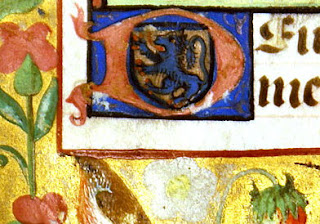Ever since encountering one of his manuscripts at Sam Fogg's, circa 2000, I have had an interest in medieval manuscripts from the collection of Harry A. Walton (d.2007), a dairy farmer of Covington, Virginia. They can be recognised by his purple ink-stamp, of which I show two examples here, and by comparison with the descriptions in the Supplement to de Ricci's Census.
A more detailed list, with photographs (but of course omitting those previously sold to Fogg or others) is provided by the posthumous auction catalogue of his collection, sold in New York in 2009. Lot 15 in the sale was an interesting Book of Hours illuminated by an otherwise unrecorded artist:
In both catalogues it is described as being imperfect, with 31 miniatures, with the bookplate of Edward Mars Elmhirst [1915-1957], and bound in old black morocco, with the Elmhirst crest in gilt on upper cover. An example of his crest is on the British Armorial Bindings website:
There are a few biographical details of Elmhirst here.
The origin of the manuscript is hard to determine. The 1954 Sotheby's catalogue tentatively suggested "Bourges?"; "Bourges use" was stated as a fact in the Supplement to de Ricci; and this was repeated when the manuscript was described in the 2009 catalogue. This is certainly wrong. Now that the book is broken up, it may never be possible to study the liturgical clues properly, but the first lesson of the Office of the Dead, "Milicia est vita hominis" (on the leaf with the miniature of Job) is extremely rare and, according to K. Ottosen, The Responsories and Versicles of the Latin Office of the Dead, 1993, p.74, is only found in sources from Châlons, so this is one possible origin.
The patron of the manuscript is shown kneeling before the Virgin and Child at the beginning of the prayer "O intemerata" (shown at the top of this post) and a rampant lion in one of the initials could possibly be heraldic:
The manuscript was apparently bought at the 2009 auction by a Leipzig dealer and broken up; single leaves were being offered at German auctions by the end of the same year. A list of the leaves of which I am aware, with images, is on a new membra disiecta page here.
One leaf with a miniature, was acquired by the University of South Carolina in 1973 (Early MS 67; see Scott Gwara, A Census of Medieval Manuscripts in South Carolina Collections, 2007, no.82 pp.46, 48). It has the ink stamp of François Cesar Le Tellier, marquis de Courtanvaux (1718-1781), about whom there is a good notice on Jean-Luc Deuffic's provenance site here.
As this is the only leaf known to have been removed from the volume before 1954, and as it is also the only one with the Courtanvaux ink-stamp, I suspect that it was removed from the volume precisely because it has the stamp, and the owner wanted to obscure the provenance of the book.
South Carolina have also bought a text leaf since 2009; images and descriptions of both can be found here.
Jean-Luc provides a link to a digitized copy of the 1782 Courtanvaux auction catalogue at the New York Public Library:
It has prices added by hand. In the section on "liturgies" there are at least two lots, 36 an 40, whose descriptions might very well refer to the present manuscript:
Some copies have the date "M. DCC. LXXXIII." instead of "M. DCC. LXXXII." on the title-page:
These were apparently printed a year after the auction, and include a printed price-list at the end. This confirms that lot 40 sold for six times as much as lot 36:
A manuscript identified as lot 41 is described here; another possible candidate is no.3 here; a manuscript identified as 42 is described here and here; and an ex-Courtanvaux Roman de la Rose is in Philadelphia, described here.











No comments:
Post a Comment
** PLEASE INCLUDE YOUR NAME IN YOUR COMMENT **
I may ignore and delete anonymous comments